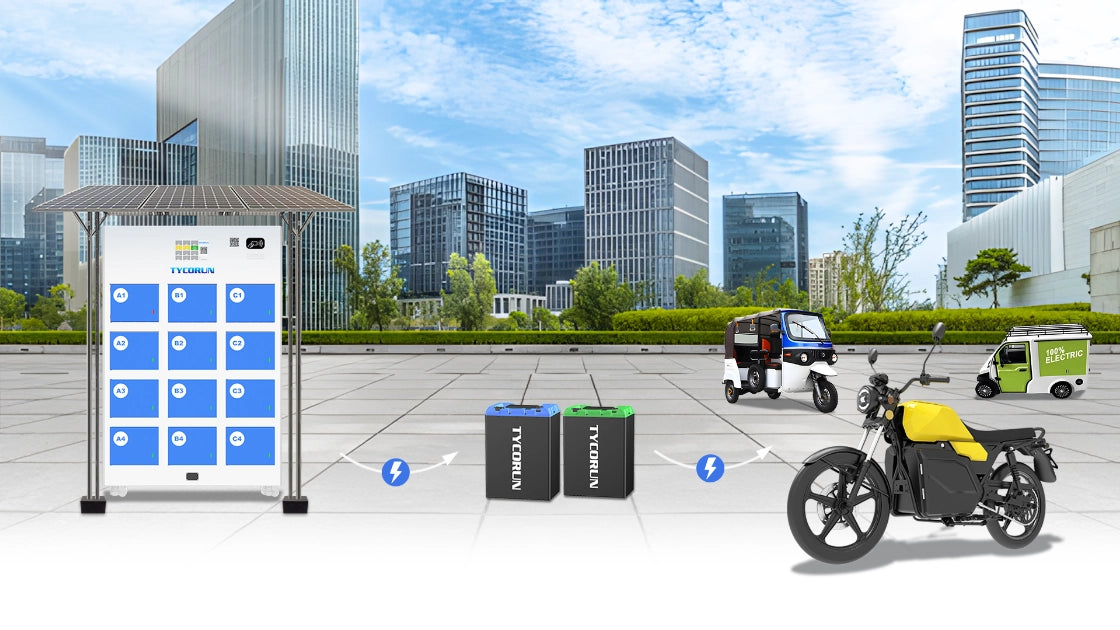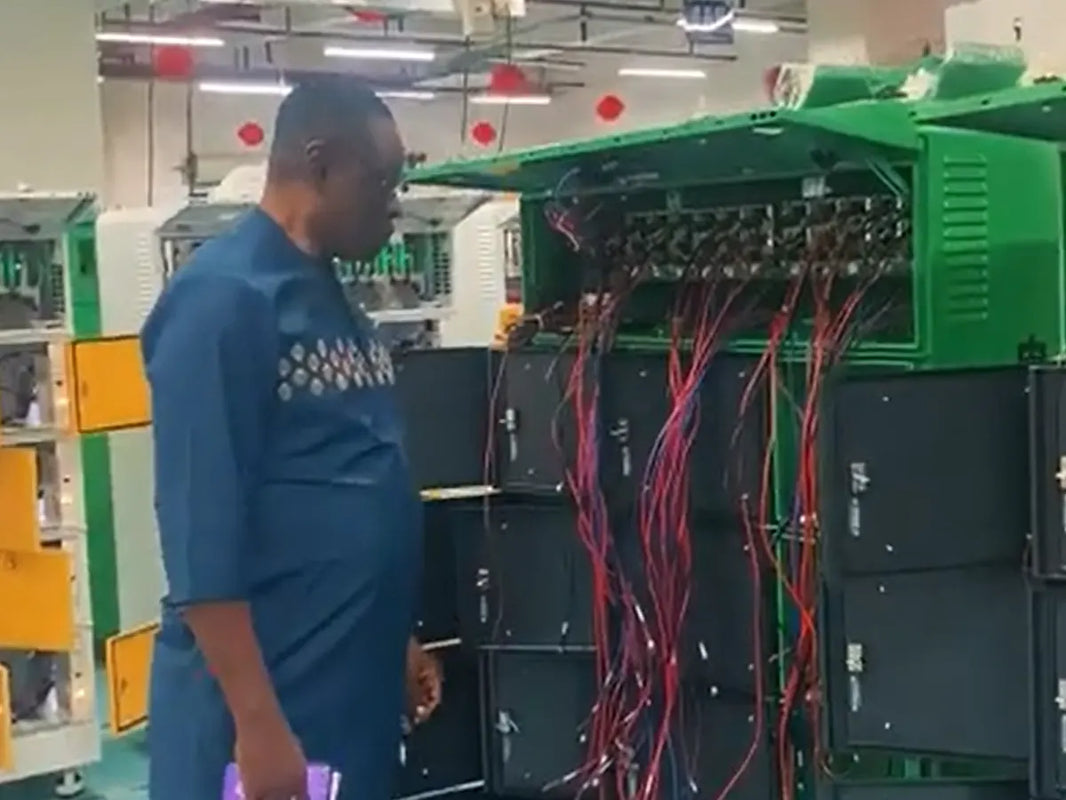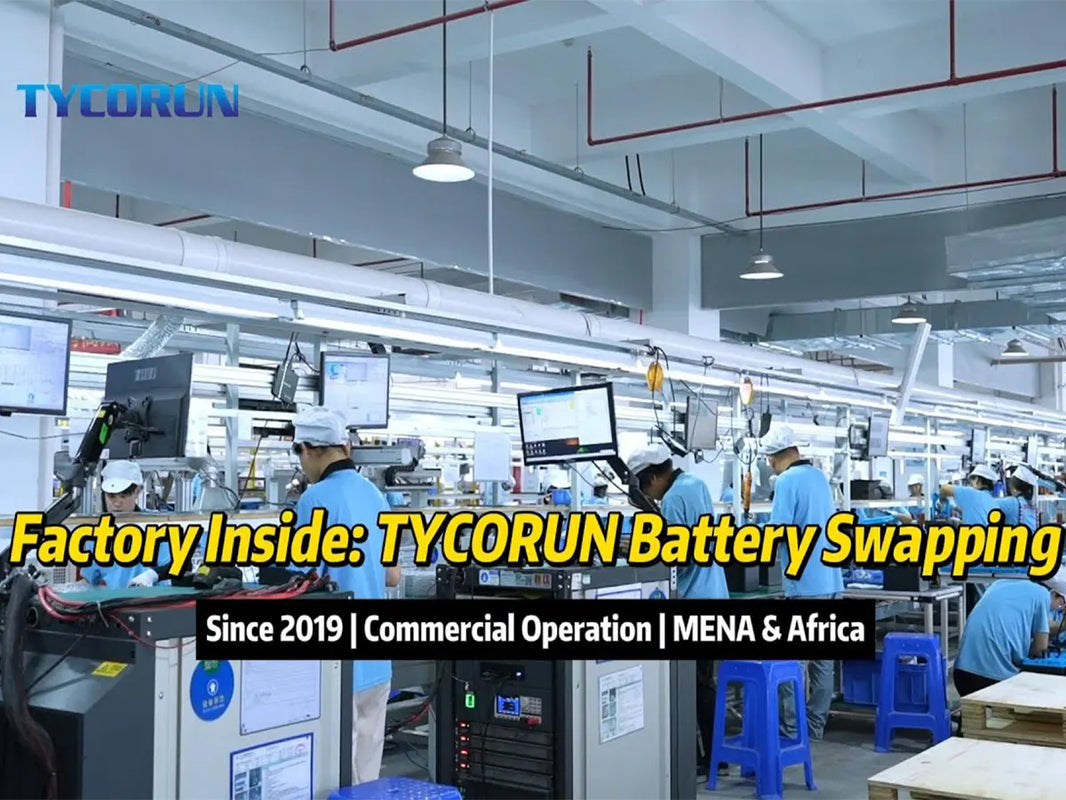
Main content:
- What Is Battery Swapping?
- How Does Battery Swapping work?
- What Many Types of Rechargeable Batteries are Required to Operate a Station?
- Top 10 Benefits of Battery Swapping
- The Challenges of Battery Swapping
- How Battery-as-a-Service is Cost-Effective for Riders
- What Are the Uses of Battery Swapping?
- Why Should Choose TYCORUN Battery Swap
- FAQ
Electric vehicles (EVs) are becoming increasingly popular across the globe, especially in Southeast Asia, where two-wheelers and small electric vehicles dominate urban transport. However, one of the major challenges hindering the adoption of EVs is charging infrastructure. This is where battery swapping comes in as a practical and innovative solution.
In this article, we will explain what is battery swapping, how it works, and why TYCORUN’s battery swapping system offers an effective solution for electric vehicle users.
What Is Battery Swapping?
Battery swapping is a process where an electric vehicle’s depleted battery is quickly replaced with a fully charged one, instead of waiting for the battery to charge. This method dramatically reduces downtime and increases the convenience of owning an EV.
So, what is battery swapping in simple terms? It’s essentially a quick “battery refill” system for EVs, making electric vehicles more practical for daily commuting.

How Does Battery Swapping work
How battery swapping works? It’s very simple. You take out your empty electric motorcycle battery from your electric vehicle and put in a fully charged one. When you connect the battery to the swap station for charging, the system automatically recognizes it and sends the battery information to a central platform. This lets the system check the battery’s condition in real time.
The swap station can also share power smartly to charge many batteries at once. Depending on its size, a station can hold and charge 5 to 12 or even more batteries at the same time. Battery swapping technology lets you quickly replace empty batteries with fully charged ones, so your electric vehicle is ready to use without waiting for long charging times.
What Types of Rechargeable Batteries are Required to Operate a Station?
A battery swapping station can operate with different types of rechargeable batteries, depending on the vehicle and system design. The most common types include:
| Battery Type | Advantages | Limitation | Use in Swapping Stations |
| Lithium-Ion (Li-ion) | High energy density, lightweight, fast charging, widely available | Slightly higher cost | Most common in electric scooters/motorcycles |
| Lithium Iron Phosphate (LiFePO4) | Very safe, long lifespan, stable at high temperatures | Lower energy density than Li-ion | Preferred for frequent swaps, long-term durability |
| Nickel-Metal Hydride (NiMH) | Stable, reliable, good thermal tolerance | Lower energy density, heavier, slower charging | Rarely used today in modern EVs |
| Solid-State Batteries | High energy density, extremely safe, longer life potential | Expensive, still in development | Emerging technology for future swapping stations |
Top 10 Benefits of Battery Swapping
Understanding what is battery swapping also involves recognizing its advantages. Battery swapping offers multiple benefits for riders,battery swapping stations business model, and EV infrastructure. Here are the top ten:

1. Reduces Downtime
Battery swapping significantly cuts waiting time—swapping a depleted battery for a fully charged one takes only minutes, compared to the hours required for traditional charging. This is especially beneficial for high-turnover commercial fleets like taxis and delivery vehicles.
2. Extends Vehicle Range
By enabling continuous operation with full-powered batteries, swapping helps maintain optimal performance and alleviate range anxiety, making long-distance travel more feasible through a network of well-maintained battery stations.
3. Smarter Battery Management
Battery swapping makes battery care easier by keeping charging, maintenance, and monitoring in one place. These stations check and charge batteries properly, fix issues early, and update software to keep them in good condition. This helps batteries last longer, work better, and lower long-term costs.
4. Cuts Upfront EV Costs
Drivers can lease batteries instead of purchasing them outright, making electric vehicles more affordable. The service provider handles battery maintenance and replacement, shifting financial and technical responsibility away from users.
5. Maximizes Energy Efficiency
Swapping stations can charge batteries during off-peak hours and apply optimal charging methods, reducing grid strain and enhancing battery health while making EV energy use more efficient.
6. Reduces Infrastructure Needs
Battery swapping requires less complex infrastructure than fast-charging stations. Strategies like off-peak charging and compact station design reduce both construction and operational expenses.
7. Adapts to Multiple Battery Types
Swapping systems can accommodate multiple battery types and chemistries, enabling users to upgrade as technology evolves without replacing the vehicle.
8. Promotes Standardization and Compatibility
Uniform battery designs and interfaces encourage interoperability across vehicle models and manufacturers, simplifying supply chains and promoting industry-wide compatibility.
9. Removes Range Anxiety
With quick and predictable access to get fully batteries, drivers are reassured and empowered to travel longer distances without worrying about running out of power.
10. Optimizes Fleet Operations
Fast battery swap times dramatically boost operational efficiency for logistics, ride-hailing, and public transport fleets. Batteries charge centrally, often during low-demand periods, optimizing uptime and energy use.
The Challenges of Battery Swapping
1. Standardization
Different EV models use various battery sizes and connectors, making a universal swapping solution difficult.
2. High Initial Investment
Setting up battery swapping stations requires significant capital for batteries, cabinets, and smart management systems.
3. Battery Ownership Models
Some users may prefer owning their batteries, but swapping often works on a subscription or pay-per-use model.
4. Logistics and Maintenance
Stations need efficient inventory and maintenance management to ensure battery availability and performance.
Addressing these challenges is essential for scaling battery swapping infrastructure successfully. Companies like TYCORUN are designing flexible and modular systems to overcome these barriers.
How Battery-as-a-Service is Cost-Effective for Riders
Battery-as-a-Service (BaaS) complements battery swapping by allowing users to pay for battery usage rather than purchase it outright. Here’s why this is cost-effective:
- Lower Upfront Costs: Riders can buy an electric vehicle without the expensive battery.
- Flexible Payment Plans: Monthly subscriptions or pay-per-swap options make budgeting easier.
- Reduced Maintenance Expenses: The provider manages battery health, eliminating unexpected replacement costs.
- Predictable Operational Costs: Subscription fees cover battery use, ensuring riders know their expenses in advance.
By combining battery swapping with BaaS, users enjoy convenience, cost savings, and peace of mind while riding electric vehicles.
What Are the Uses of Battery Swapping?
Battery swapping serves multiple purposes across different sectors:

-
Urban Commuting
Electric motorcycles and scooters benefit from fast battery replacement, allowing riders to travel without long waits for charging. -
Delivery and Logistics
Companies using EV fleets for deliveries can maintain high operational efficiency. Swapping batteries ensures vehicles remain in service all day. -
Ride-Hailing Services
Scooters or small EV taxis can swap batteries quickly between trips, improving availability for drivers and passengers. -
Rental and Sharing Services
Battery swapping ensures vehicles in rental or sharing programs remain available and fully charged for users, reducing downtime. -
Sustainable Mobility
Swapping stations can use renewable energy to charge batteries, supporting green transportation initiatives.
Overall, battery swapping provides practical solutions for time-sensitive and high-usage applications.
Why Should Choose TYCORUN Battery Swap
Choosing TYCORUN Battery Swap means getting access to one of the most versatile and advanced swapping solutions in the market. TYCORUN offers a wide range of battery types to suit different electric motorcycle needs, including 60V 30Ah lithium battery, 72V 30Ah lithium battery, 76V 40Ah LiFePO4 battery, 73V 30Ah semi-solid battery, 73V 45Ah semi-solid battery, as well as fully battery swap station customization.
Its intelligent battery cabinets are designed for secure storage for battery swap station safe, automated charging, real-time monitoring, and optimized battery health management, ensuring every swap delivers a reliable and fully charged unit. Integration with the TYCORUN mobile app makes the experience seamless, allowing users to locate nearby stations, check battery availability, reserve units, and make payments directly from their smartphones.
The technology behind TYCORUN as swappable battery manufacturer includes advanced battery management systems (BMS), temperature control, fast charging capabilities, and safety protections to prevent overcharging or short circuits. With a solid warranty program and best-in-class after-sales support, TYCORUN ensures users enjoy worry-free, efficient, and safe battery swapping for their electric mobility needs.

FAQ
1. How To Saving Costs with a Smarter Battery Swapping System?
With TYCORUN battery swapping, riders can change their battery in just 15 seconds, making deliveries faster and more efficient. At the same time, the system manages all batteries from a central platform. It can track which cabinets have available batteries, which ones are charging, fully charged, in use, or need maintenance. This helps reduce downtime, extend battery life, and lower overall operational costs.
2. Can TYCORUN Work with My Current Electric Vehicles?
Yes. TYCORUN offers customized development services to fit your needs. Whether it’s the battery size, voltage, or connector type, the system can be adapted for many two- or three-wheeled electric vehicles. This includes different models used for city deliveries, food delivery, courier services, or even passenger transport.
3. How long does it take to swap a battery?
TYCORUN makes swapping quick and easy. In just 60 seconds, you can get a fully charged battery from the swap station and continue your ride without long waiting times.
Related Article: How To Use Battery Swap Station Correctly, Battery Swap vs Charging, Battery Swapping Station Classification















